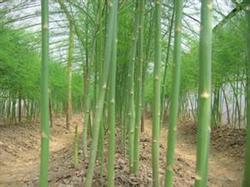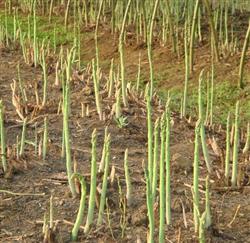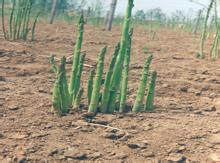Management techniques of fertilization and soil cultivation of asparagus

1. Fertilizing and cultivating asparagus should use more organic fertilizer to make the soil loose and fertile, which is beneficial to the development of underground stem and root system. The amount of fertilizer was comprehensively considered according to the plant growth, soil fertility and utilization rate. The plant growth includes the yield of tender stem, the weight of aboveground stem and the growth of underground stem and fleshy root. According to the annual yield of 400 kg per mu of tender stem, the absorption of asparagus to the three elements is 6.96 kg of nitrogen, 1.8 kg of phosphorus and 6.2 kg of potassium. When fertilizing, the utilization rate of nitrogen and potassium is about 50%, and that of phosphorus is 20%. In addition, 20% of the nutrients needed by the plant already exist in the soil, so the actual amount of fertilizer should be 11.1 kg of nitrogen, 7.2 kg of phosphorus and 9.9 kg of potassium. White asparagus harvested from May to August in the first year after seedling planting was combined with ploughing and loosening soil, and thin human fecal urine was applied around the plant for 3-4 times to promote the growth of plant clusters. In the following spring, ditches were opened at 30-40 cm from the plant on both sides of the plant, and 1500-2000 kg of compost, 25 kg of calcium superphosphate, 1200 kg of human feces and urine or 12 kg of urea were applied per mu, mixed with soil and then covered with soil. The tender stems were harvested in the third year after planting. After the tender stem was harvested, compost 2000-2500 kg per mu, 1200 kg of human feces and urine, 35 kg of superphosphate and 15 kg of potassium chloride were applied in the middle of the furrow. After ploughing and loosening the soil in summer and autumn, thin human feces and urine and potassium chloride were applied near the plant for 2-3 times. The key point of topdressing should be arranged when the plant is growing vigorously in autumn. If green asparagus is harvested, the fertilization method in the first year after planting is the same as that of white asparagus. From the second year, the focus of fertilization is in spring, followed by autumn. The following spring, before smoking young stems, dig deep ditches in the middle of the furrow and apply compost, human feces and urine, calcium superphosphate and potassium chloride, etc. The amount of various fertilizers is about 70% of that of white asparagus after harvest in the third year. Thin human feces and urine and potassium chloride were applied 2-3 times near the plant in summer and autumn. The amount of fertilizer applied in the spring of the third year was 30% higher than that of the second year. The amount of fertilizer will be increased appropriately after the fourth year. 2. Cultivate the soil to harvest white asparagus, cultivate the soil before the young stem is born in spring, so that the young stem can not see light, and become a white and tender product. The suitable period of soil cultivation is 1-2 weeks before the expected emergence of bamboo shoots. It is about 20 cm in the third year after planting and about 40 cm after the fourth year. In short, according to the plant size, it is estimated that the ground where young stems can be produced should be cultivated. The thickness of the soil should be based on the fact that the underground stem of the plant is buried 25 cm below the soil surface. When cultivating the soil, the soil surface is required to be flat and slightly tightened to prevent light leakage and collapse. The thickness of the soil must always be maintained during bamboo shoot picking. If the height of the ridge is reduced due to soil compaction or rainstorm erosion, it should be processed immediately. After the tender stem is harvested, the soil ridge should be raked off, so that the border surface can be restored to the height before soil cultivation, and the position of the underground stem should be kept 15 cm below the soil surface. If covered with black plastic film, the border surface can also be dark, so that the young stems drawn out of the ground can not see the light and show a white and tender state. At the same time, after covered with black film, the soil temperature is easier to rise than that of cultivated soil, bamboo shoots can be produced earlier, and it is more convenient to pick bamboo shoots. Using black film covering instead of soil cultivation can also save a lot of labor. After the surface is slightly dry, hoe and hoe can increase the ground temperature, reduce water evaporation and promote root development. Cover the earth. The fine soil after hoe is buried on the planting ditch. At present, it can cover 1 cm first and then cover 1 cm before freezing, which can not only keep warm, but also prevent the surface from drying and cracking. Water before winter. According to the situation of their own land, at the discretion, as long as the hand can grasp the soil into a ball, it will not be watered, not a small amount of water can be poured into a ball. Management after the beginning of spring. After the beginning of spring next year, we will enter the period of returning to green in mid-March. before turning green, we will do the work of spraying medicine to prevent diseases, fertilizing and promoting seedlings, and watering green water. After that, the soil was covered step by step, so that the original planting ditch was gradually ridged.
- Prev

Chemical weeding in asparagus field
Asparagus row spacing is large, easy to breed weeds, white asparagus harvest period ridging, bamboo shoots do not come out of the ground, chemical weeding is also difficult to implement. The main weeds of asparagus are Chenopodium (gray stripe), field whorl (playing bowl flower), Cyperus roxburghii (Trigonium), Castanopsis grossedentata, barnyardgrass, dog tail and so on. It is often used to kill during spring harvest.
- Next

Sowing and planting of asparagus in open field
Asparagus is a kind of high-grade vegetable and health food with high nutritional value, which enjoys the reputation of "king of vegetables" in the international market. The asparagus planting area in Baoding City is more than 14000 mu, of which the bamboo shoot field area is more than 8000 mu, with an annual output of more than 7500 tons. All are sold in Beijing, Tianjin and other big cities. The planting area of asparagus is gradually.
Related
- Where is it suitable to grow horseradish in China? it is expected to see the middle altitude horseradish in Alishan.
- How to prevent tomato virus disease reasonably? (Control methods included)
- Many people like to plant towel gourd on the balcony. What are the main points of this method and management?
- What crops can chili peppers be mixed with?
- Fertilization techniques and matters needing attention in Tomato
- What are the grafting techniques for peach seedlings in spring?
- Harm and control methods of root swelling disease of Chinese cabbage
- What are the pests of sweet potatoes? How to prevent and cure it?
- Symptoms, causes and Control methods of navel Rot in Tomato
- The cause of "Cucumber rotten bibcock" in Farmers' planting Cucumber and its Control Plan

